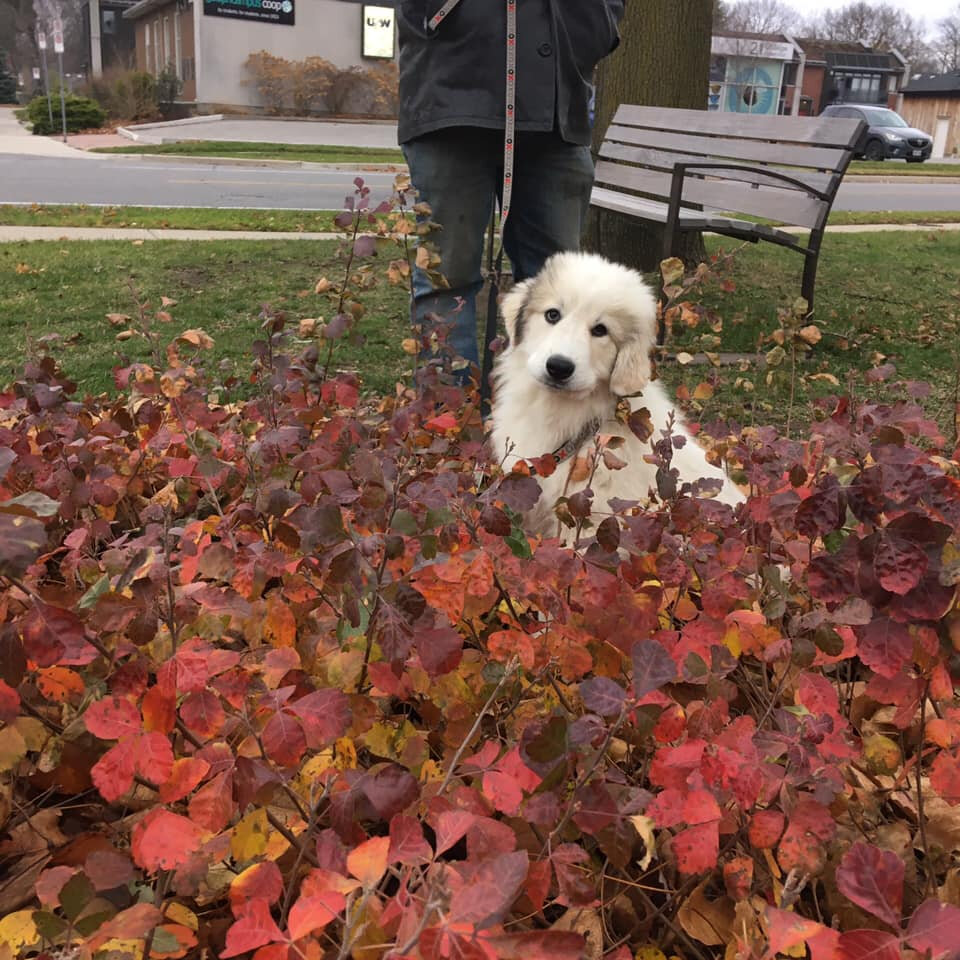Those who know us, also know our dogs.
The Kirks are a dog-loving family, and have had dogs since their children were small. Although they started with Pugs, their first larger dog Bosco led them to the Great Pyrenees through his own mixed heritage (DNA tested showed a mix of White Shepherd, Great Pyrenees and another livestock guardian breed). In 2019 they reached out to breeders Cidwm Great Pyrenees, and in August of 2020 they took home their first purebred Pyrenees, Venger. Then a little under a year later, they added their second Pyrenees, a half-sibling to Venger, who they called Wolf.

Since then they have spent a lot of time with the Great Pyrenees, and are happy to tell anyone who asks all about this ancient breed.
Almost daily, Wolf is to be found in the office, acting as supervisor. He checks the incoming people traffic and provides opinions on weather and activity levels. Occasionally Venger comes in too, to claim her admiration from her followers (as she has successfully trained our staff to fawn over her). The Kirks love their dogs and the traits they exhibit. As such, they felt it sensible to share a bit of the technical history of the breed with everyone.
Brief History of the Great Pyrenees
Katherine Goliboski, shared from Cidwm Great Pyrenees
The Great Pyrenees, a majestic breed known for their loyalty and protective nature, has a rich history that traces back to the Pyrenees Mountains, where they served as livestock guardian dogs for centuries.
As a part of the Molosser group, they are believed to descend from ancient dogs of used by Roman legions for protection and herding. The term Molosser (as described by the American Molosser Association) "...derives from Molossia, a subregion of ancient Epirus, in North-West Ancient Greece".
The Great Pyrenees, known for its striking primarily white coat (although colour is common in original examples, and the current standards allow up to 1/3 of the body to be in colour) and gentle demeanour, has a rich history that traces back over 2,000 years to the mountainous regions of France and Spain, particularly the Pyrenees Mountains. Originally bred to guard sheep and livestock from predators, these dogs exemplified resilience and dedication, often working alongside shepherds in harsh conditions. Their strong protective instincts and loyalty made them indispensable in rural communities, leading to their recognition as a national treasure in France. Over the centuries, the Great Pyrenees has transitioned from a working dog to a beloved companion, finding a place in many households while still retaining its natural guarding abilities. As they have grown in popularity in various parts of the world, the breed has maintained a reputation not just for their physical strength and endurance, but also for their gentle nature and affectionate temperament, making them cherished family pets today.
Their popularity surged in 17th-century France, particularly during the reign of Louis XIV, who favoured the breed for its impressive stature and gentle demeanour; so calm in fact that they came to be termed "mat dogs" as acknowledgment of their tendency to lie about until called upon. The Great Pyrenees became emblematic of nobility and were often seen accompanying the Sun King in his opulent court, serving both as companions and guardians. Their affinity for children and families further solidified their status, as they were not only protectors of sheep but also cherished family pets in the royal households. The breed's enduring legacy continues as a symbol of loyalty and grace, deeply rooted in both history and culture.
A Great Pyrenees, when guarding a flock in the Pyrenean Mountains, performs several vital tasks to ensure the safety of the animals. These include patrolling the grazing area, using their keen senses to detect potential threats such as wolves or other predators, and establishing a protective perimeter around the flock. They are known for their strong bond with the sheep and will often bark or display assertive behaviour to deter intruders. Additionally, they require socialization and training to work effectively with the shepherd and adapt to the various terrains and conditions of the mountains. Their instinctive guarding behaviour, combined with their loyalty and independence, makes them excellent guardians in this challenging environment.
The Great Pyrenees continue to represent a rich legacy of household pets and working dogs, reminding us of the vital relationship between humanity and animals in safeguarding our cultural and agricultural heritage.
|